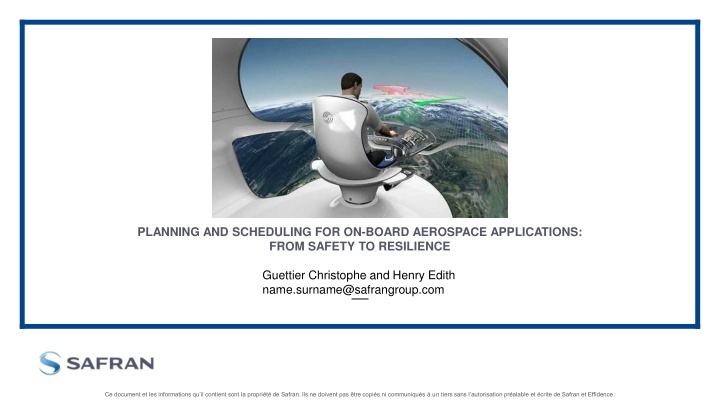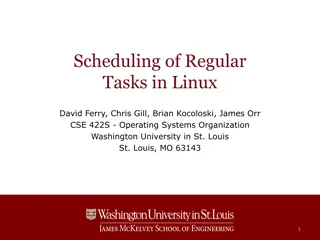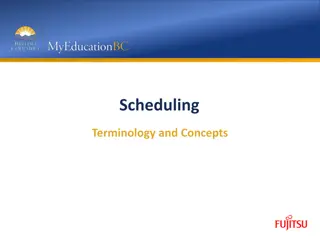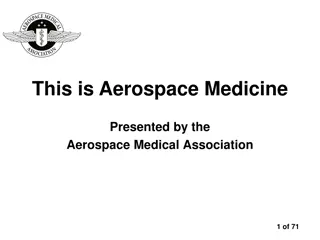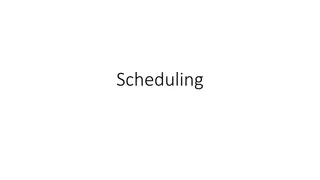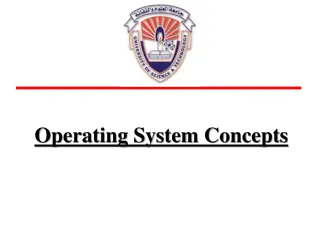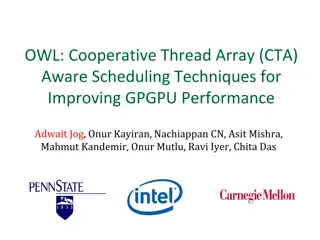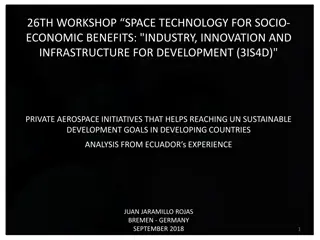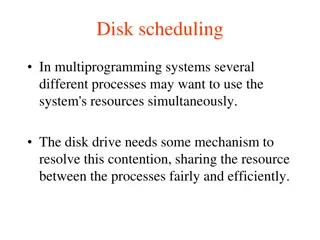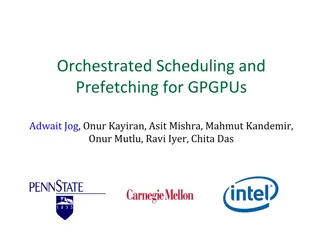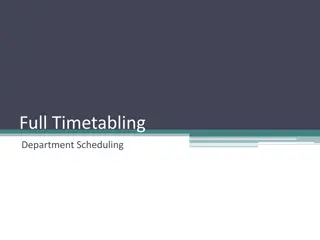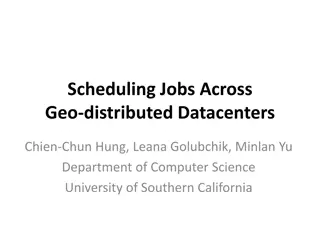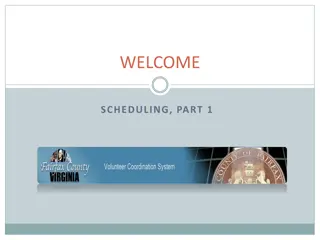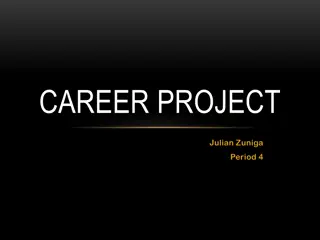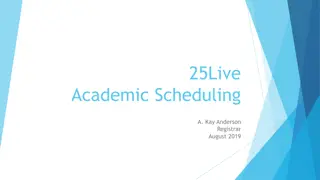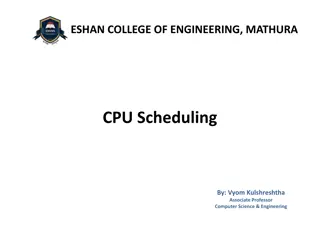Planning and Scheduling for On-Board Aerospace Applications: From Safety to Resilience
This document discusses planning and scheduling for on-board aerospace applications, focusing on safety and resilience aspects. It covers topics such as autonomous control, classic engineering with finite state automata, and autonomous system context. The content explores scenarios related to propulsion systems, ion drives, mixed CSP solving, and model-based diagnosis extensions. Various control strategies, certification conditions, and system verification approaches are also mentioned.
Download Presentation

Please find below an Image/Link to download the presentation.
The content on the website is provided AS IS for your information and personal use only. It may not be sold, licensed, or shared on other websites without obtaining consent from the author.If you encounter any issues during the download, it is possible that the publisher has removed the file from their server.
You are allowed to download the files provided on this website for personal or commercial use, subject to the condition that they are used lawfully. All files are the property of their respective owners.
The content on the website is provided AS IS for your information and personal use only. It may not be sold, licensed, or shared on other websites without obtaining consent from the author.
E N D
Presentation Transcript
PLANNING AND SCHEDULING FOR ON-BOARD AEROSPACE APPLICATIONS: FROM SAFETY TO RESILIENCE Guettier Christophe and Henry Edith name.surname@safrangroup.com Ce document et les informations qu il contient sont la propri t de Safran. Ils ne doivent pas tre copi s ni communiqu s un tiers sans l autorisation pr alable et crite de Safran et Effidence.
Autonomous System Context Unknown environment Short term uncertainty and contingencies Partially known environment Long term uncertainty Known and mastered environment Full controlability Autonomous Control Planning for mobility Automata Automatic System Scheduling Planning and scheduling for mission Separate validation, global certification System level verification, validation, certification? 2 Ce document et les informations qu il contient sont la propri t de Safran. Ils ne doivent pas tre copi s ni communiqu s un tiers sans l autorisation pr alable et crite de Safran.
Classic Engineering: Finite State Automata Example sketch of a propulsion system > Burst > After-burner > Safe-mode > Emergency > Cool-down Temperature vs Thrust SAFRAN Ion Drive Current practice > Finite state automaton > Determinist > Reactive > Avoid Parallel States Reset Thrust After Burner Certification conditions Safe Cool Down => Real time, instantaneous control Horizon 4 Ce document et les informations qu il contient sont la propri t de Safran. Ils ne doivent pas tre copi s ni communiqu s un tiers sans l autorisation pr alable et crite de Safran.
Autonomous Control Cf. Anytime Behaviour of Mixed CSP Solving N Yorke-Smith, C Guettier (2004) Warning Alarm Heat Reset T >Tmax CoolDown Boost Heat Boost Non controlable disjunctions Normal Temp T =<Tmax Thrust Choice Alarm System control False Alarm Emergency cool down T <Tmax Environment control Nominal temp Nominal thrust T <Tnominal Cool Down Extensions to model based diagnosis > Constraint violation on current state => diagnosis > Constraint violation on future state => Predictive diagnosis Reset T <Tnominal Reseting => Short term control Horizon, fail safe Other modelling approaches to investigate: PDDL2.2, DTNU 4 Ce document et les informations qu il contient sont la propri t de Safran. Ils ne doivent pas tre copi s ni communiqu s un tiers sans l autorisation pr alable et crite de Safran.
P&S for Mobility and Mission Input: > Mission Start and End or Initial / Final Conditions (resourcs, state) > Terrain Structure: Navigation graph of possible WayPoints > On board resource consumption > Observations actions set to perform, with timing, exposure and Solving: > A*, D*Lite, > Dedicated Constraint Solving > Phase transition pattern Observation Areas O1 O2 Action structure: Precondition: > At Position, Speed, Time > On-Board Resources Status Post condition: > Time > Effect (information acquired?) > On-Board Resources consumption O3 O4 Recovery Point resource conditions Output > Navigation plans > Actions that can be realised Starting point Resilience level: Unsafe plans => Fail operational Preconditions with uncertain variables Disjunctive post conditions => Long term Horizon 6 Ce document et les informations qu il contient sont la propri t de Safran. Ils ne doivent pas tre copi s ni communiqu s un tiers sans l autorisation pr alable et crite de Safran.
Integration, Verification, Validation and Certification and AI Tensions IVQ SW+HW V&V IV&V SW AI Planning Algorithms 1 AI Strategy Logical inference, SAT, constraint solving, CSAT Search Agent based architecture FPGA (meta)Heuristics Domain-independent heuristics 2 Autonomous A* and extensions (D*, D*Lite, ), other planning algorithms, Specifics? Interactive (speech, ) Domain heuristics CPU, MultiCPU, MIMD Cooperative, Collaborative Models Data Distributed 3 Probabilist Planning (POMDP) Hybridation GPU Sizing / Compilation Combinatorial explosion, Global representations / models Behaviorial 6 Ce document et les informations qu il contient sont la propri t de Safran. Ils ne doivent pas tre copi s ni communiqu s un tiers sans l autorisation pr alable et crite de Safran.
Conclusion IVQ and Certification methodology Bound the functional domain over a given horizon (temperature, flight enveloppe) Address Model Predictive Control How to adapt existing methodologies to P&S implementations for certified application Live testing, dynamic validation approach? Certification also needs to address learning stages how to perform a test drive? Combine several planners with different functionalites Need segregated architectures Redundant with disymetric architectures (both functional and structural) Opportunities for failure diagnosis and prognostic needs for comparable performances! Which hardware shall be used? FPGA is more adequate to certification processes, For CPU/GPU, how to address OS issues related to support of planning functionalities 8 Ce document et les informations qu il contient sont la propri t de Safran. Ils ne doivent pas tre copi s ni communiqu s un tiers sans l autorisation pr alable et crite de Safran.
